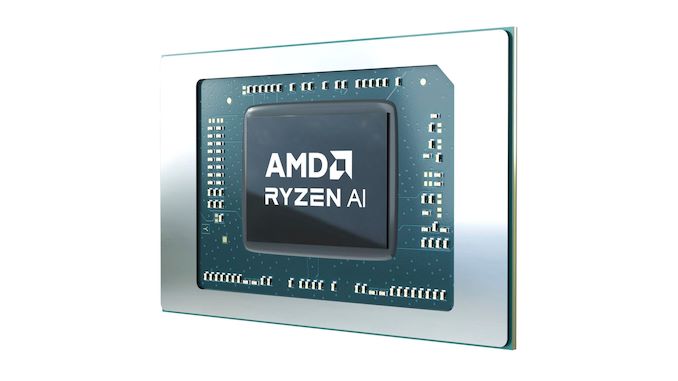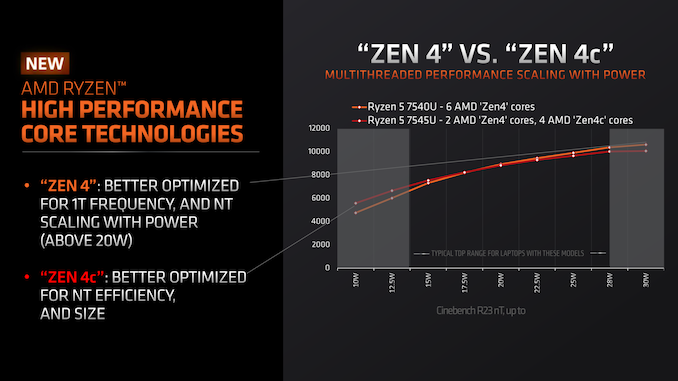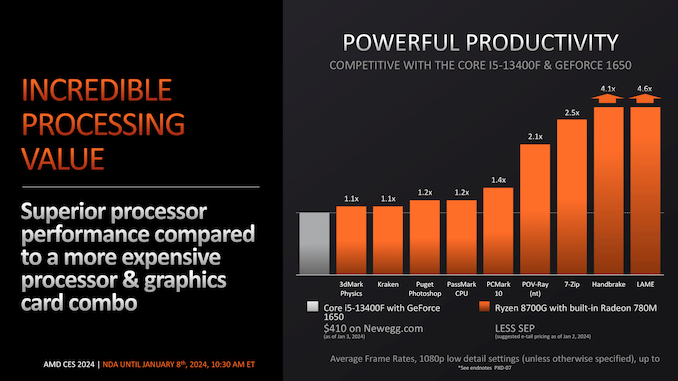
While it’s been touted for many months that AMD will release APUs for desktops based on Zen 4, rumors and wishes have finally come to fruition during AMD’s presentation at CES 2024 with the announcement of the Ryzen 8000G family. The latest line-up of APUs with Zen 4 cores and upgraded Radeon integrated graphics consists of four new SKUs, with the Ryzen 7 8700G leading the charge with 8 CPU cores and AMD’s RDNA3-based Radeon 780M graphics. It offers users a more cost-effective pathway to gaming and content creation without needing a discrete graphics card.
The other models announced include the AMD Ryzen 5 8600G and Ryzen 5 8500G, both of which offer 6 CPU cores and integrated graphics, all with a 65 W TDP. Bringing up the rear will be the AMD Ryzen 3 8300G, a modest, entry-level 4 core offering. AMD will be tapping both their Phoenix (1) and Phoenix 2 silicon for these parts, depending on the SKU, meaning that the higher-tier parts will exclusively use Zen 4 CPU cores, while the lower-tier parts will use a mix of Zen 4 and Zen 4c CPU cores, a similar split to what we see today with AMD’s Ryzen Mobile 8000 series.
AMD Ryzen 8000G Series: Zen 4 APUs for Desktop
As AMD pushes into 2024, the big focus is on AI, with the Ryzen 7 8700G and Ryzen 5 8600G both coming with the Ryzen AI NPU embedded into the silicon for better on-chip generative AI performance and inferencing capabilities. As has been the case with AMD for a few generations now, their Ryzen 8000G series APUs aren’t made from new silicon, but rather are mobile silicon packaged up for desktop use, with AMD tapping their Phoenix and Phoenix 2 designs from the Ryzen Mobile 7000/8000 series.
Aimed primarily at entry-level users and gamers on a budget, the AMD Ryzen 8000G encompasses many elements that make the Ryzen 7000 desktop series and the Ryzen 8000 series mobile chips attractive. Firstly, all four of the new Ryzen 8000G series SKUs have a 65 W TDP, which is more than their mobile offerings, but still has plenty of give in the tank on desktop considering the included Radeon RDNA3-based graphics.
Much like the previous Ryzen series APUs, such as the Zen 3-based Ryzen 7 5700G, Ryzen 5 5600G, and Ryzen 3 5300G, AMD’s Zen 4 series of APUs offers the performance and power efficiency benefits of a monolithic, mobile-first die while remaining competitive in the entry-level desktop space. Pivoting back to the target market, AMD promises ‘ready to game out of the box at 1080p’ levels of performance, which despite being a lower resolution than high-end gamers are accustomed to, such as 1440p and 4K, 1080p is still the most widely used resolution by the average gamer according to the latest Steam Hardware Survey That being said, these chips aren’t designed for AAA gaming at 1080p, and if users want to play demanding titles, expect to dial down the quality settings.
| AMD Ryzen 8000G Desktop Series | |||||||||
| Cores | Base Freq |
Turbo Freq |
GPU | GPU Freq |
Ryzen AI (NPU) |
L3 Cache (MB) |
TDP | MSRP | |
| Ryzen 7 | |||||||||
| Ryzen 7 8700G | 8x Z4 | 4200 | 5100 | R780M 12 CUs |
2900 | Y | 16 | 65W | $329 |
| Ryzen 5 | |||||||||
| Ryzen 5 8600G | 6x Z4 | 4300 | 5000 | R760M 8 CUs |
2800 | Y | 16 | 65W | $229 |
| Ryzen 5 8500G | 2x Z4 4x Z4c |
3500 | Z4: 5000 Z4c: 3700 |
R740M 4 CUs |
2800 | N | 16 | 65W | $179 |
| Ryzen 3 | |||||||||
| Ryzen 3 8300G* | 1x Z4 3x Z4c |
3400 | Z4: 4900 Z4c: 3600 |
R740M 4 CUs |
2600 | N | 8 | 65W | OEM Only |
| *Currently OEM only (End of Q1 2024, other SKUs available 31/01/24 | |||||||||
Focusing on the specifications of AMD’s Ryzen 8000G series APUs, three options will be available to users at retail, with the entry-level Ryzen 3 8300G being available only to OEM partners at the moment. These include one 4C/8T option (OEM), two 6C/12T, and one 8C/16T chip to select from.
Starting with the top tier SKU, the Ryzen 7 8700G, it is based on AMD’s Pheonix mobile silicon and, as such, benefits from eight fully-fledged Zen 4 cores driving sixteen threads (8C/16T). At the top end, it has a 5.1 GHz turbo frequency with a 4.2 GHz base frequency. Encompassing the true nature of an APU for AMD’s AM5 desktop platform, it includes the Radeon 780M integrated graphics, which is RDNA3-based and supports AMD’s latest features, such as Hyper-RX and Fluid Motion Frames. The Radeon 780M itself has 12 CUs, with 768 shader units (1536 ALUs) with a clock speed of 2.9 GHz, and forms part of a trifecta of on-chip AI inferencing capabilities, which AMD claims provides up to 39 TFLOPS of performance when combining the Ryzen AI NPU, iGPU, and CPU cores.
The AMD Ryzen 5 8600G is one step down from the 8700G and, as such, has six full Zen 4 cores and a turbo core frequency of up to 5.0 GHz, while the base frequency runs at 4.3 GHz. It also features AMD’s Radeon 760M RDNA3 integrated graphics cores, with 8 CUs and 512 shader units at 2.8 GHz. Along with the Ryzen 7 8700G, the Ryzen 5 8600G also includes the Ryzen AI NPU engine block built into the silicon, with both SKUs making use of the technology AMD picked up from their acquisition of Xilinx in 2022.
Third up is the AMD Ryzen 5 8500G. Which, despite the minor change in model numbers is actually a pretty big change under the hood, as this is where AMD switches from Phoenix (1) to Phoenix 2 silicon. The 8500G packs two full-fat Zen 4 cores with 4 petite Zen 4c cores. The whole chip has a base clockspeed of 3.5GHz, while the Zen 4c cores can clock up to 3.7GHz, and the big cores can go all the way to 5.0GHz. The switch to a smaller die here means that the 8500G loses the Ryzen AI NPU, and its integrated GPU drops down to the 4 CU Radeon 740M, with a peak GPU clockspeed of 2.8GHz. With these specifications, the Ryzen 5 8500G is very similar to the Ryzen 5 8540U mobile processor, but with a higher 65 W TDP and adapted for use with AMD’s AM5 desktop platform
This last of the four Ryzen 8000G series SKUs is the entry-level model Ryzen 3 8300G, which will only be available to system integrators and OEMs for now. It consists of one full Zen 4 core with three Zen 4c cores, and the single Zen 4 core can hit 4.9 GHz at turbo frequencies. Besides dropping more CPU cores, this chip also loses half of its L3 cache, bringing it down to 8MB of L3 joining the 4MB of L2 split amongst the CPU cores.
AMD has provided some in-house performance figures focusing on the Ryzen 7 8700G with the Radeon 780M integrated graphics. Using a plethora of games at 1080p with low detail settings, AMD showcases that the Ryzen 7 8700G can handle AAA games such as Cyberpunk 2077, Far Cry 6, and Assassin’s Creed: Valhalla at an average framerate above 60 fps. Other less demanding titles, such as F1 2022, Dota 2, and League of Legends, average over 100 fps, which shows that the combination of Phoenix based Zen 4 cores and the Radeon 780M graphics offers a pathway to gaming on desktop for $379.
Regarding compute performance, AMD compares it directly to Intel’s 13th Gen Core i5-13400F with an NVIDIA GeForce 1650 and claims up to 1.1 x the 3DMark Physics performance, up to 2.1 x the POV-Ray nT performance. In Handbrake and LAME, AMD claims up to 4.1 x performance and beyond. Of course, take any figures provided by a vendor or manufacturer with a pinch of salt, but AMD is aiming to dominate the entry-level market with its Zen 4 APUs.
Ryzen 8000G Series: Some all Zen 4, Some Zen 4 + Zen 4c
Because AMD is using both of their Phoenix APU dies for the Ryzen 8000G series, this is where things get a little interesting. Both the Ryzen 5 8500G (6C/12T) and the Ryzen 3 8300G (4C/8T) are using a mix of Zen 4 and smaller yet more power-efficient Zen 4c cores, rather than a homogenous block of Zen 4 cores, much like the previously released Pheonix 2-based Ryzen 3 7440U.
The end result is that the peak clockspeed is not consistent across all of the cores in the chip, and instead depends on whether it’s a Zen 4 core or a Zen 4c core. Due to their smaller size and lower power envelope overall, Zen 4c cores have a notably lower clockspeed ceiling, on the order of 3.7GHz or so, versus 5.1GHz for the regular Zen 4 cores.

AMD Zen 4 vs. Zen 4c comparison on Ryzen 7000U Series Mobile
So in all-core turbo scenarios, which these desktop chips are better positioned to hit and sustain due to their relatively high TDPs, the use of Zen 4c cores is likely to have a greater impact than we’ve seen with AMD’s mobile parts. This should help drive a larger performance gap between the two hex-core parts, the 8600G and 8500G, which for AMD is not the worst thing in the world.
The use of Phoenix 2 also means that the Ryzen 5 8500G and Ryzen 3 8300G come with a relatively small iGPU, via the 4 CU Radeon 740M. Though it’s worth noting that while small by Phoenix APU standards, it’s still twice as many CUs (and a generation newer) than the integrated GPU found on AMD’s mainline Zen 4 desktop chips. So even the 8300G should run circles around the 7900X and its ilk in GPU-limited scenarios.
All of AMD’s Ryzen 8000G series processors come with a 65 W TDP, regardless of the core/thread count and which integrated graphics chip is used. It’s unclear whether or not these parts are overclockable, as the Ryzen 3 7440U (Phoenix 2) is NOT overclockable and represents a similar configuration to the Ryzen 5 8500G and Ryzen 3 8300G. As the Ryzen 3 8300G is a 4C/8T chip (fundamentally), it only comes with 8 MB of L3 cache, which isn’t ideal for gaming and would be more suitable for an entry-level system with a decent enough iGPU to handle basic tasks without a discrete graphics card; this seems to be its biggest selling point on paper.
AMD says that the Ryzen 7 8700G will hit retail at $329, with the Ryzen 5 8600G coming in at $229, and the Ryzen 5 8500G rounding out the collection at $179. All three SKUs will be available to buy starting January 31st. The Ryzen 3 8300G will only be available to system builders, and even then it isn’t expected to start landing in systems until the end of Q1 2024.










